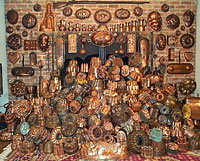Copper Arts Museum to Open in Clarkdale
 The collection of the Meinke family
The collection of the Meinke familyCourtesy of Elaina Meinke
A new museum dedicated entirely to works in copper, bronze and brass is now taking shape in the desert town of Clarkdale, Arizona. In the town's old high school, the Copper Art Museum will house and exhibit selected pieces from the thousands collected over three generations by the Minnesota-based Meinke family, which is funding the entire effort.
The collection began in 1919, when Pearl Meinke opened an antiques shop in northern Minnesota. Copper exerted a special appeal from the very beginning and became the primary focus in the early 1960s when John and Pat Meinke took over the family business.
In the year 2000, under the leadership of Clark and Elaina Meinke, the family began searching for new directions for their collection.
"It was at this point that we started thinking about establishing a museum devoted to copper, partly as a place to store the collection, but mostly as a way to share the collection with others who love copper as much as we do," says Elaina Meinke.
As the Meinkes began their search for a suitable location, Arizona immediately came to mind because it's "The Copper State." Then it was a matter of finding the right town. At first, Jerome looked like the ideal place - a mining town set on the slopes of the mountain under which the state's largest copper mine was located. But there were no buildings in Jerome large enough for the kind of museum they envisioned. Just down the hill, however, was the town of Clarkdale and an old high school there was for sale. Even better, Clarkdale was a company town created in 1912 to serve the workers at a new smelter works owned by the same company that owned the mine under Jerome. Business boomed in the paired towns until the mid-50s, when the ore ran out and the smelter closed down.
"It was a tough history for a lot of people, but it was the perfect place for us because it was all about copper," says Clark Meinke. "So, in 2002, we bought the school and got to work."
When the museum opens in 2011, its spaces will display weather vanes, architectural panels, cupolas, musical instruments, and laboratory and medical equipment. However, the vast majority of the works exhibited will consist of cookware, service ware and decorative ware: pots, pans, roasters and molds; trays, urns and tureens; candelabra and vases; and just about any other type of object that might be found in the kitchen or dining room of a home or estate.
While a small number of pieces date to the Bronze Age, the collection starts in earnest with the 16th Century and emphasizes wares produced in Europe and America.
Clark Meinke describes how "you have to get well into the 1500s and the new supply of copper coming from the New World before you start seeing greater numbers and a greater variety of copper pieces. Copper was such a valuable and useful material that just about everything made from it would be melted down and remade into other things."
Determining a precise age for a piece is often difficult anyway, Meinke points out. Very few older pieces bear the name or stamp of their maker and even fewer are dated. There's also the problem that copper was considered a poor man's metal and often was created by skilled but uncelebrated smiths or artisans, even by people we'd today call hobbyists. The only way to approximate a date for most of these pieces is by trying to match them to details in contemporary paintings, murals and tapestries whose origins are better established.
This kind of research reveals that animal motifs were particularly popular during the 1700s and that botanical motifs such as grapes, florals and leaves dominated the 1800s. The overall shape of a piece is similarly revealing of the era that produced it.
By the early 20th century, however, these temporal and stylistic distinctions begin to break down. Nowhere is this more apparent than in the Meinke's extensive collection of "Trench Art;" works created by soldiers from all over Europe serving on both sides of World War I. To relieve the alternating boredom and anxiety of battle, and to produce souvenirs, they engraved spent brass artillery shells and bullet casings with images of the local terrain and maps of battlefields where they'd fought. They re-shaped the cylindrical forms into models of tanks and airplanes, and occasionally produced forms that served as vases or tankards for beer. The stylistic and technical variation of these pieces commingled traditional habits of working copper from regions throughout Europe and the United States. It was a truly international effort that effected copper craftsmanship and design ever since.
Also in this Issue:
- Kaleidoscoping Copper: Alan and Andy Tolley
- Fit for a King's Dog: Collier Leeds
- Mountain Metalsmiths: Reflecting Nature's Beauty with Copper
- Copper Arts Museum to Open in Clarkdale
- George Segal on View at the Nasher Sculpture Center
